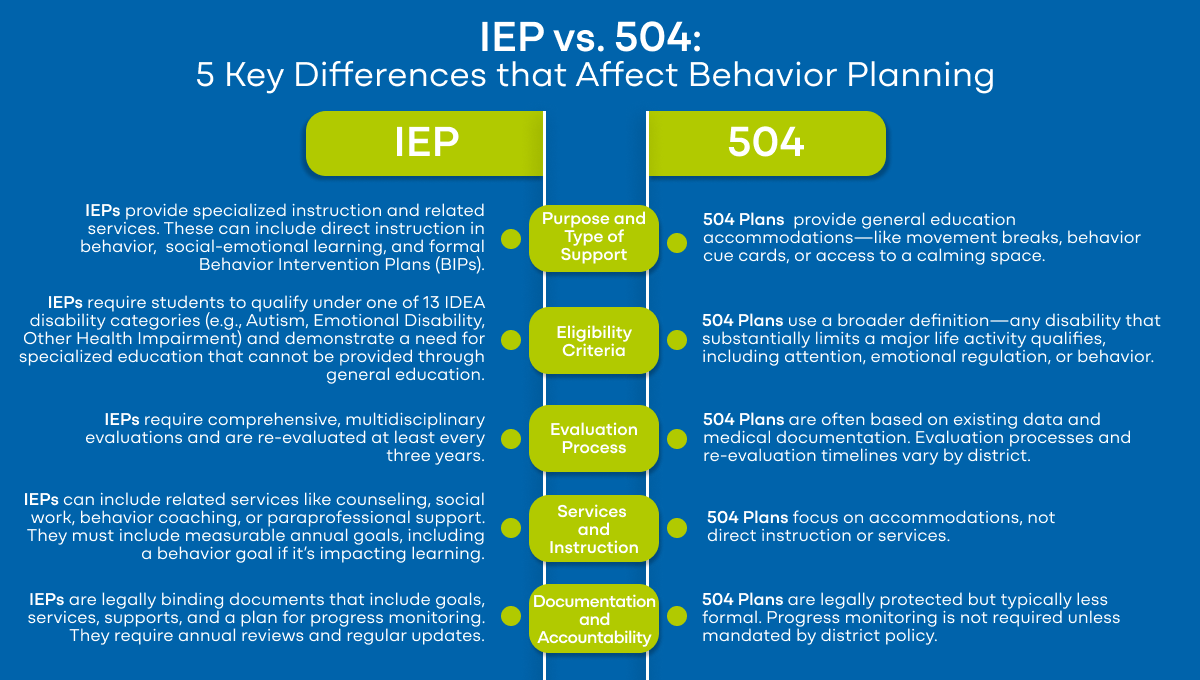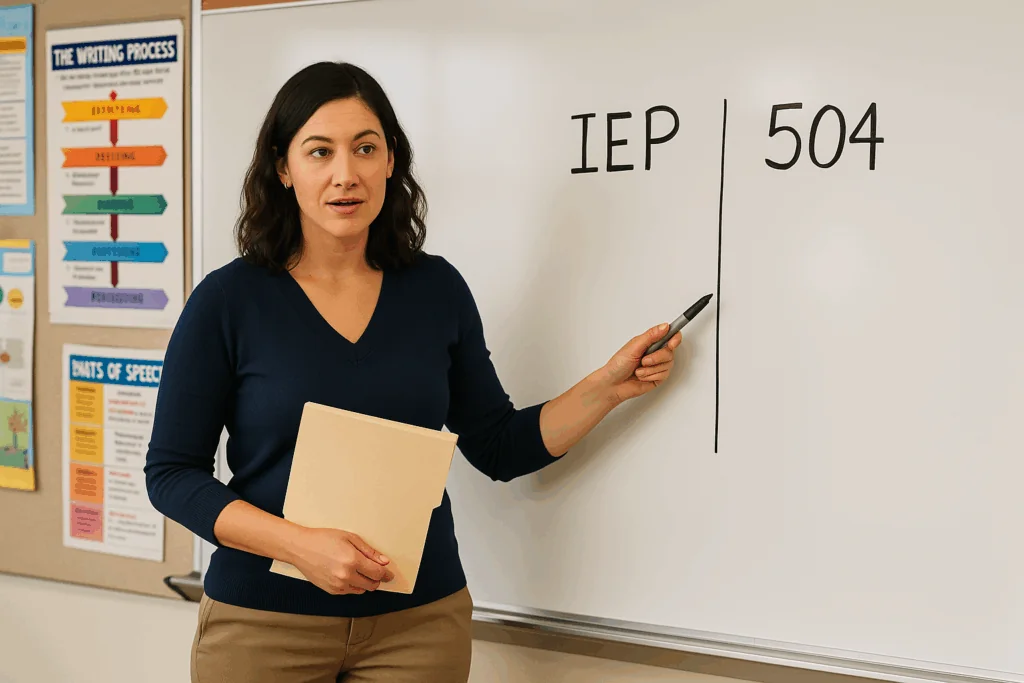When a student struggles with behavior at school, one of the first questions teams often ask is: Should we consider a 504 plan or an IEP?
While these two supports come from different laws and offer different levels of service, they both provide legal protections and access to support for students with disabilities. What matters most is aligning support to the student’s unique needs, through collaborative problem-solving and often as part of a broader Multi-Tiered System of Supports (MTSS).
Let’s explore five key differences between IEPs and 504 plans—plus how both can be powerful tools for behavior support when teams work together to create and monitor meaningful plans.
Legal Foundations: Different Laws, Shared Purpose
IEP (Individualized Education Program): Governed by the Individuals with Disabilities Education Act (IDEA), IEPs are for students who require specially designed instruction to make educational progress. IDEA outlines eligibility criteria, procedural safeguards, and mandates a Free Appropriate Public Education (FAPE).
504 Plan: Stemming from Section 504 of the Rehabilitation Act of 1973—a civil rights law—504 plans ensure students with disabilities are not discriminated against and receive accommodations necessary to access learning.
Both can be used to support behavior, but they differ in structure, intensity, and team requirements.
1. Purpose and Type of Support
IEPs provide specialized instruction and related services. These can include direct instruction in behavior, social-emotional learning, and formal Behavior Intervention Plans (BIPs).
504 Plans provide general education accommodations—like movement breaks, behavior cue cards, or access to a calming space.
💡 Behavior Insight: Whether it’s an IEP or a 504, the key is matching the support to the function of the student’s behavior.
2. Eligibility Criteria
IEPs require students to qualify under one of 13 IDEA disability categories (e.g., Autism, Emotional Disability, Other Health Impairment) and demonstrate a need for specialized education that cannot be provided through general education.
504 Plans use a broader definition—any disability that substantially limits a major life activity qualifies, including attention, emotional regulation, or behavior.
💡 Behavior Insight: A student with ADHD might receive a 504 plan for accommodations. If their behavior significantly affects learning and skill development and they require specialized support, they may qualify for an IEP that includes behavior instruction and goals.
This free Behavior IEP Goal Template can help ensure clear, meaningful goals are written and implemented
3. Evaluation Process
IEPs require comprehensive, multidisciplinary evaluations and are re-evaluated at least every three years.
504 Plans are often based on existing data and medical documentation. Evaluation processes and re-evaluation timelines vary by district.
💡 Behavior Insight: IEP evaluations can include Functional Behavior Assessments (FBAs) to inform Behavior Intervention Plans (BIPs). While 504 teams should also consider behavioral data, they are not typically required to conduct a formal FBA.
4. Services and Instruction
IEPs can include related services like counseling, social work, behavior coaching, or paraprofessional support. They must include measurable annual goals, including a behavior goal if it’s impacting learning.
504 Plans focus on accommodations, not direct instruction or services.
💡 Behavior Insight: IEPs support skill-building (e.g., requesting breaks, coping strategies) through goals and specialized instruction. 504s support access (e.g., quiet workspace, check-in systems) through structured accommodations.\
Equip your team to write strong, student-centered goals with Behavior Advantage’s SEL goal writing guide and behavior goal bank.
5. Documentation and Accountability
IEPs are legally binding documents that include goals, services, supports, and a plan for progress monitoring. They require annual reviews and regular updates.
504 Plans are legally protected but typically less formal. Progress monitoring is not required unless mandated by district policy.
💡 Behavior Insight: Monitoring behavior data is critical in both cases. IEPs require documentation of progress toward behavior goals. 504s should track accommodation effectiveness to ensure fidelity and impact.

Supporting Behavior Through Both Plans
Whether a student has an IEP or 504, success hinges on clarity, consistency, and collaboration. Effective behavior support is:
- Aligned with the function of behavior
- Created and implemented by a team
- Embedded in MTSS and reviewed regularly
For IEP Teams:
- Develop function-based BIPs using function-based problem solving or FBAs
- Write clear, measurable behavior goals
- Use shared tools for data collection and reviewing progress
For 504 Teams:
- Identify environmental accommodations that reduce barriers
- Standardize supports across classrooms
- Provide guidance for consistent implementation and review
Behavior Advantage supports teams using both processes. From simple accommodations to formal BIPs, the platform helps ensure that support strategies are easy to implement, track, and refine.
Real-Life Example
Two middle school students both struggle with staying in class when frustrated:
- One student has an IEP under the category of Emotional Disability. The team uses Behavior Advantage to complete an FBA and build a BIP with goals for coping strategies. Supports are monitored and refined using BA platform data tools.
- The second student has a 504 plan due to anxiety. His team uses Behavior Advantage to implement and track accommodations like Check-In/Check-Out and a calm corner across classrooms.
In both cases, consistent behavior support improves student outcomes.
Final Thought: The Right Plan + The Right Support
IEPs and 504 plans aren’t competing tools—they are different pathways to the same goal: helping students succeed. The decision isn’t about which one is “better,” but which one is most appropriate given a student’s needs.
When it comes to behavior, the best results come from teams working collaboratively, using data to guide decisions, and anchoring support in clear, consistent plans regardless of the process.
🎯 A solid behavior plan, whether formalized in an IEP or supported by a 504, is one of the most effective ways to help students grow.
Let’s give every student the clarity and consistency they need to succeed.










